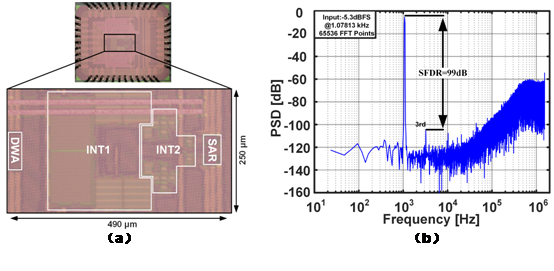Professor LIU Liyuan, a member of High-Speed Image Sensing and Signal Processing Research Group in the State Key Laboratory of Superlattices and Microstructures, Institute of Semiconductors, Chinese Academy of Sciences has taped out a low-power high-performance Delta-Sigma modulator chip. The according paper titled “A Discrete-Time Audio Modulator Using Dynamic Amplifier With Speed Enhancement and Flicker Noise Reduction Techniques” has been accepted by the top-class publication in the field of integrated circuits design, IEEE Journal of Solid-State Circuits (JSSC).(https://ieeexplore.ieee.org/document/8862953)
ADCs composed by Delta-Sigma Modulators dominate the high-accuracy low-power signal acquisition and processing applications, such as in the Internet of Things (IoT) nodes, which is an important research interest of mixed-signal integrated circuits design. Under the support of National Key Research and Development Program of China, Major Projects of the Ministry Science and Technology of China and the Youth Innovation Promotion Association Program, the group proposed a novel dynamic amplifier to design the switched-capacitor (SC) integrator and two kinds of flicker noise reduction techniques to reduce noise, which are utilized together to realize the low-power high-performance Delta-Sigma modulator.
The designed modulator applies the second-order feedforward structure, including two novel dynamic amplifier based SC integrators and a four-bit successive approximation register quantizer. The novel timing method avoids the issue of voltage drop; the proposed speed-up branches improve the differential mode settling of integrators without impeding their common mode characteristics and the developed flicker noise reduction techniques favor the signal to noise ratio (SNR). The modulator is fabricated in 65 nm CMOS process. The measurement results show that it achieves a signal to noise and distortion ratio (SNDR) of 89.6 dB and a dynamic range (DR) of 91 dB and it only consumes 49-μW power from the 0.8-V supply. Figure 1(a) shows the microphotograph of this chip and Figure 1(b) shows the measured output spectrum. The first author of the published paper is PhD student MA Song.

Figure 1. (a) Chip microphotograph. (b) Measured output spectrum
